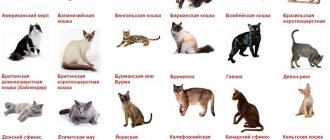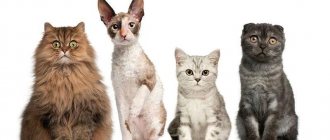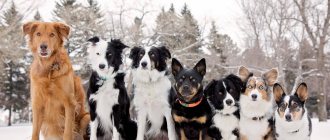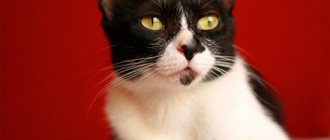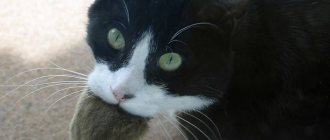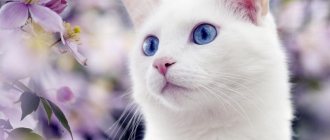Article navigation
A table that will help determine the breed of a catFeatures of pedigree kittensWhat is a breed?How to recognize the breed of a cat by its special coatVery longLong curlyShort curlyHairlessClassification of breedsHead Main distinguishing featuresSize and body structurePawsTailShape of earsType of fur and colorHow to determine the breed of cats by sizeBig catsSmall catsMuzzle shapeLong noseDetermination by sizeMethods determination of cat breed by body size
Features of pedigree kittens
Determining the breed of a kitten by phenotype is not always within the power of a professional. Some have such obvious natural features that they cannot be confused with anyone else; in this case, the table at the beginning of the article will help. Others differ so little from each other that they require the help of an experienced felinologist, supported by a genetic test.
Selkirk Rex
Balinese
Signs of thoroughbredness and obtaining a pedigree are important for those cases when the pet is awaiting breeding work or an exhibition career.
It must be remembered that the upbringing, love and appreciation of a cat is not determined by the “purity” of its blood.
How to confirm the pedigree of a pet?
To return your cat to the status of a representative of noble blood, you need to show it to an expert feoinologist. After conducting an independent examination, the specialist will refute or confirm the guesses of the owner of the pet under study about the animal’s belonging to an aristocratic family. In case of proven pedigree, the tailed aristocrat will be issued a special document - a pedigree (or metric, if it is a kitten).
Sources:
https://catmolly.com/kak-opredelit-porodu-koshki/ https://dalmspb.com/porody/sposoby-opredelit-porodu-svoej-koshki-ili-kota-po-okrasu-117073/ https:// murkoshka.ru/porody/kak-opredelit-porodu-koshki.html
How to recognize a cat's breed by its special coat
You can understand what breed a domestic kitten or an adult cat belongs to by the length and structure of the coat. The coat of different cats can vary greatly.
Very long
Based on the long coat a kitten has, one can determine whether it belongs to a fairly large number of breeds.
The following cats have long, thick hair with a densely packed undercoat:
- Persians;
- Siberians;
- Turkish Vans;
- Angoras;
- Somalia;
- Norwegian Foresters - owners of feathers on their legs and a luxurious collar on their necks;
- Neva Masquerade;
- British Longhair;
- Himalayan;
- Maine Coons;
- Burmese;
- ragdoll, etc.
Long-haired breed - Persian cat
Longhaired British cat
Neva Masquerade - long-haired cat
Long curly
Cats of the following breeds have cute, wavy, long curls that you definitely want to touch:
- Bohemian Rex;
- laperm;
- Selkirk Rex.
Short curly
Unusual short tight curls adorn cats of the following breeds:
- Cornish Rex;
- German Rex;
- American Wirehair;
- Devon Rex.
The Cornish Rex is a breed with short curly hair.
Curly short-haired cats have a fur coat that resembles astrakhan fur, it is very pleasant and unusual to the touch. Rex can be identified by this feature.
Hairless
Nowadays you won’t surprise anyone with bald, scary cats. Their cohort is constantly growing thanks to the efforts of felinologists and professional breeders.
Contrary to popular belief, these cats are not always completely naked. Most often they have a residual coat, according to which they are divided into breed subgroups.
It is extremely rare for a small kitten to be born completely hairless; usually the hair falls out completely later. It is almost impossible to immediately determine what it will become in the future.
Hairless cats include:
- all sphinxes: Canadian, Don, St. Petersburg (Peterbald);
- Dwelf;
- Minskina;
- elf;
- kohanu;
- bambino;
- Ukrainian Levkoy.
Hairless cats - sphinxes
Hairless cats have truly human “facial features”. This effect is created thanks to numerous skin folds, giving the muzzle an almost meaningful appearance.
Breed classification
Felinology is a science that studies the anatomy and physiology of cats, their reproduction and selection. There are many systems for recording and assessing animals in this area. For the most part, they come down to two groups - American and European.
At cat shows, without exception, everyone is judged by genotype. Family affiliation and origin are determined by the pedigree - the main cat document, which, in fact, reflects the family tree of the pet, at least up to the fourth generation. In addition to the names of the ancestors, all colors and dates of birth, the names of the nurseries where the animals came from are indicated.
The data of the club and the association itself are necessarily recorded in the “header” of the document.
Each pedigree has its own number, by which it can be easily found in the electronic accounting system. Colors are designated by specially adopted codes.
Such a document not only indicates the pet’s ancestral affiliation, but also allows you to determine which genes it is a carrier of, and what kittens it may have.
Only the oldest American system, TICA, as the most democratic, allows assessment by phenotype - the appearance of the animal.
In this system, all individuals are divided into six categories:
- Category I - Established Breeds - lines formed as a result of selection.
- Category II - Natural Breeds - natural breeds.
- Category III Variant or Mutation Breeds - the result of genetic mutations.
- Category IV - Domestic Hybrid Breeds - interbreeding.
- Category V - Non-Domestics Source Breed Hybrids - crossing of domestic and wild animals.
- Category VI - Experimental Breeds - experimental breeds.
The cat's status code is indicated by a set of Latin letters and numbers (date of birth and personal number).
If the alphabetic code SB is written in the pedigree, such a pet is a full-fledged representative of one of the recognized breeds. Its designation and the name of the animal (usually includes the nursery's own name) are written in the first line.
There are four categories in the European WCF system. Cats are divided according to the type of cover:
- Category I - Shorthair I - animals with short hair, group 1 - includes Orientals, Siamese and Thais, Peterbald and Tonkinese cats.
- Category II - Shorthair II - animals with short hair, group 2 - all other shorthaired animals.
- III category - Semi-Longhair - semi-longhaired cats - Siberian, Maine Coons, Norwegian Forest, Nibelung, others.
- Category IV - Longhair - long-haired group - Persian only.
In this system, the pedigree number encrypts: breed, category, color and sex of the animal. A cat from the experimental group or an unrecognized variety will not be issued a document in this system.
Pedigrees of other systems are not very common in Russia. But if you need to decrypt them, you should contact the club that issued it.
Information about him and the feline system, indicating telephone numbers and addresses, is required in the document of any association.
Singapura Siberian cat
Pros and cons of purebred pets
The noble representatives of the cat family have their pros and cons. The first include:
Maine Coon kitten
- An opportunity to learn about the character and health characteristics of the future four-legged family member before purchasing. To do this, just watch the parents of the animal you like for a while. Deviations, including mental ones, are inherited.
- Upbringing. A purebred pet comes into the house already accustomed to a tray and a scratching post.
- Availability of vaccinations. Cats are vaccinated in nurseries.
- Possibility of breeding and participation in exhibitions.
- Prestigious and noble origin.
Among the disadvantages of noble cats are:
Savannah kitten
- High price. The cost of such animals depends on the breed, pedigree and breeding class.
- Hereditary diseases.
- High risk of transmitting breed-specific diseases to offspring.
- The need for constant careful care.
- High cost of content. It is especially expensive for owners to maintain pets that take part in exhibitions.
- Possibility of purchasing only older kittens. The babies are given to their future owners after they are 2 months old.
- Special terms of the contract. Some of them stipulate the need for mandatory participation in exhibitions or castration.
Head
The structure of the skull and the general appearance of the head are the hallmarks of a purebred cat. It cannot be said that each breed has its own distinct characteristics regarding the skull. To determine the breed by the appearance of the head, it is necessary to study all the values and compare them with the standards adopted for outbred cats.
If the differences are significant, then we can say with a high degree of confidence that the cat has a certain breed . It will be possible to tell what breed the pet is after the cheeks, cheekbones, nose, forehead, profile, bite, chin and nasal pads are assessed.
Eyes
You can tell what breed a cat is by looking at its eyes. This is difficult to do, because many breeds have the same eye color. Therefore, you need to pay attention not only to the color, but also to the shape and location of the eyes so that the result is correct.
For example, British cats are the only ones with orange eyes . A cat of the same breed, among other things, is endowed with strabismus. The Turkish Angora and the Turkish Van have another, but no less striking feature - eyes of different colors.
© shutterstock
Main distinguishing features
Externally, cats have more or less the same appearance. These animals have a rump and chest of medium width, and the head is rounded. In members of different species, certain aspects of their appearance acquire certain functions through reproduction. Belong to them:
- body size;
- Ear water structure (unusual shape, deformed cartilage, curled, etc.)
- Limbs (short, normal, elongated)
- fur;
- hair color.
Based on these parameters, you can indicate whether the animal belongs to a certain species. Let's look at them in more detail.
Body size and structure
The length of the average domestic cat is up to 75 cm. Their tail is about 30 cm long. Standard males weigh 4 and 6 kg and females 2.3 - 4.5 kg. Some breeds weigh much more, their body weight can reach 20 kg.
The largest races include:
- American Bobtail;
- Smoked Bobtail;
- Maine Coon;
- British cat;
- Norwegian Forest Cat;
- Ragdoll;
- Pixiebob;
- savannah;
- Turkish cat vans;
- Siberian;
- Chartreuse.
There are also small species that weigh no more than 2.5 kg. These include Bambino, Napoleon, Dulf, Kinkalova, Lantzkin, Minskin, Skif Tai-Donu, etc.
Paws
Most cats have limbs of medium length. However, many purebred animals have short legs. According to this feature, you can easily distinguish blue bloods from ordinary backyard animals. These short-earth legs are Napoleon, Minice, Dwefy, Skooki, Bambino and Munchkins. Small paws are compensated by the mobility of the spine. This spine will help you move easily with short limbs.
Tail
Cats usually have a long tail. However, some varieties have a short tail, which is a congenital trait and not a consequence of surgery. Pedigree animals can be easily recognized by this seal. However, you should check whether the short tail is not the result of injury. Breeds that have unusual tails include:
- A cat without a tail and short forelimbs. For this reason, it has a boot walk;
- The tail is only 2 and 15 cm long;
- Animals without a tail or with a very long tail;
- American Bobtail tail length no longer than the base of the hind legs;
- Japanese bobtail about 12 cm long;
- Kurilian Bobtail.
Even the rarest races can be easily recognized after building the tail.
Ear shape
Non-studded animals have a typical mustard design. With aristocrats, the ears often have an unusual appearance:
- Tilt up to 180 degrees; American curl;
- with deformed cartilage, which collects mustard up to half; Scottish spotted cat;
- Curly; from representatives of Ukrainian diversity LWIE CAT;
- Patterned and large in size; Elf cat.
Other aristocratic races will have ears similar to one of the types described above.
Coat type and color
The definition of a purebred animal is always based on the Ukan and its coloring. All aristocratic varieties have their own characteristic hair cap colors.
Breeds differ in hair length. For short-haired varieties include: Tonkiy, Siamese, Abyssian, Singaporean, Cork, Bombardier. Maine Coon, Simrak, Persian, Balinese and Ragdoll Wu Long hair. There are also hairless species, the Ukrainian lion and the sphinx.
Curly short hair is found in almost all varieties of Rex: Germanic, Devonian and Cornish cats. Long-haired curly breeds are Behema and Selirk Rex. American Shorthair breeds have a coarse coat with bouncy curls.
It is necessary to understand that the presence of an unusual color in a street kitten already indicates the presence of aristocratic relatives.
Varieties such as the Thai, Nevsky, Balinese and Siamese have dark paws, muzzle and tail. The Ragdoll, Burmese and Snow Show members all have white socks and a black tail, paws and mouth area.
Russian Blue, British and Nibelung are distinguished by their smoky gray or blue color. Abyssinians and Somalis have a sandy color. Bengals, Egyptian Mau, Safari and Savannah cats have bright stripes and spots. Havana, Brown or Tiffany-Chantilly have brown fur.
Mestizos can have characteristics of several races at the same time. This is a common occurrence when species mix. Despite the differences noted above, only a breeder or veterinarian can accurately determine the breed.
Using the above parameters, you can approximately determine whether we have a purebred cat or not. No matter what type of cat it is, it needs a balanced diet, good and proper care and love from you.
How to determine cat breed by size
You can distinguish an ordinary street cat from a purebred cat by its size. The vast majority of simple murkas do not exceed 50-75 cm in length (80-105 cm with tail). At the same time, the body weight of a cat varies between 4-6 kg, and that of a cat - 2-4 kg.
Pedigree animals can weigh much more - 15-20 kg, and be very tiny, whose weight does not exceed 1.3-2 kg.
Big cats
Giant cats belong to the following breeds:
- Turkish van;
- Maine Coon;
- Norwegian forest;
- chartreuse;
- bobtail (Kurilian and American);
- savannah;
- Siberian;
- British;
- pixie bob;
- Egyptian Mau;
- ragdoll
Large cat breed - Maine Coon
Large cat breed - American Bobtail
Large cat breed – Norwegian Forest
Little cats
You can determine whether the purchased kitten belongs to mini-cats by comparing it with representatives of the following breeds:
- lambkin;
- bambino;
- Skookum;
- minskin;
- munchkin;
- Kinkaloe;
- minuet;
- Dwelf;
- Singapore.
Small munchkin cat
Small cat of the bambino breed
In almost all cat breeds, the weight of an adult is strictly regulated. Cats and cats that do not fit the standard are not allowed for breeding.
Tail
The most characteristic feature after physique, as it is susceptible to mutations. You can determine the breed of an animal by its woolly fringes and tail length. Oriental cats have long and thin tails.
Wool fringes are also long, sparse, and often form a feather. Taillessness in these pets is achieved by genetic characteristics, and not by docking, as in dogs.
If your pet's tail is completely absent, then you are dealing with a Cymric or Manx. Their front legs are shorter, and when walking they bounce slightly, compensating for the lack of a rudder such as a tail.
A very short and medium-length tail is observed in bobtails of various types and pixie-bob cats, which look like a tiny lynx.
They are very short in munchkin cats. These cats represent the dachshunds of the cat world - ideal paws do not exceed four centimeters in height, so the animal practically walks on its belly.
Representatives of this breed were bred from ordinary domestic cats, so your pet may well turn out to be a standardized munchkin. Another type of dwarf breed, the Skookum, walks on short legs and has a lush collar of wavy hair.
Dwelf cats are very short in stature and have absolutely no hair, just like tiny bambinos.
Unusual placement of the ears on the head is a characteristic feature of breeds with mutations. Scottish Folds have forward-hanging ear tips, and they droop in kittens at three weeks of age. The British and exotics also show off their ears down.
Graceful American Curls have ears that curl back, a feature not seen in any other breed. Ears of particularly large sizes are found mainly in Abyssinian cats, sphinxes (those without hair) and orientals.
All cats of Asian origin have large ears accompanied by an elongated muzzle with subtle, expressive features.
True, there are cases when a “nobleman” found on the street or taken from a nursery turns out to be a high-breed animal. Then its owner has the opportunity to obtain a certificate from the evaluation commission and establish a pedigree line in the first generation.
To do this, you need to compare the external parameters of your pet with the above standards and classify it as a particular breed, and then seek advice from professionals.
However, even if your pet is classified as a simple domestic cat, do not be upset. He loves you, and will love you no matter what - that's what makes domestic cats so valuable.
Sizing
When answering the question of how to find out the breed of your cat by size, take into account that most ordinary domestic cats have a body length ranging from 50 to 75 cm. The length of the tail usually does not exceed 30 cm, and the weight is 4-6 kg in cats and 2−4.5 kg in cats. However, sometimes the breed characteristics of animals are manifested in the increased dimensions of their bodies. This sign helps determine the pet’s breed.
Thus, the largest species of animals include:
- Kuril Bobtail (domestic breed bred on the Far Eastern islands of Iturup and Kunashir);
- pixie bob (an artificially bred species in the USA, the representatives of which resemble the red lynx in appearance);
- Turkish Van (one of the most ancient breeds on Earth);
- American Bobtail (bred from wild cats in North America);
- Chartreux (French breed, known in its homeland as “dog-cat”);
- forest Norwegian (the body weight of males of this species can reach 10 kg);
- British;
- Maine Coon;
- Siberian;
- ragdoll;
- savannah.
There are breeds of cats whose weight is less than that of most domestic animals. The most common of them:
- Munchkin (a breed that was often involved in crossbreeding to develop new varieties);
- bambino (the result of crossing a munchkin and Canadian hairless sphinxes, whose weight does not exceed 2.5 kg);
- skookum (obtained from a cross between munchkins and laperms, have wavy long fur);
- Singaporean (bred in Singapore, then exported to the USA and Europe);
- kinkalow (the rarest type of cat, representatives of which weigh about 1.3 kg);
- Napoleon (the result of crossing Persian cats and munchkins, weighs about 2.5 kg);
- lambkin (animals with curly hair, like lambs, weigh about 1.8 kg as adults);
- Dwelf (a breed of animals without hair, obtained as a result of crossing Munchkins, American Curls and Canadian Sphynxes, weighs about 3 kg);
- Minskin (small and light cats without hair);
- Scythian-tay-don (the smallest cats in the world, better known as “toybob”).
Color
When determining the breed of a cat, first of all, pay attention to the distinctive features of the animal, since they are what distinguish one breed from another. Cats for the most part are built typically - not like dogs, in which breed diversity is determined by differences in height, weight, size and other parameters.
Dark fur with light socks on the paws, a light tip of the tail and a white muzzle is the lot of Ragdolls, Burms and Snowshoes. Moreover, their coat length varies from short to medium.
There are not so many cats with pure sandy hair
A rare pearly blue color coupled with silver gray can be found in Nibelungs, Chartreuxes, animals that belong to the Russian Blue breed and, of course, Scottish Folds and Scottish Straights. There is a so-called wild color.
Methods for determining cat breed
Here are the main points that will help determine the breed if the table above does not cope with this:
- Mutation signs and features. More often it is the shape and size of the ears - for example, curled back in Curls or drooping in Scottish Folds. Tassels on the tips are also a characteristic feature (Caracat, Maine Coon). The short length of Munchkin's limbs, fixed by a mutation gene, also makes him easily recognizable.
- The color of the iris, their shape and location. Some lines have only one eye color (blue - Siamese, green - Nibelungs) or multi-colored, like the Turkish Van. Asian cats, in addition, have a characteristic oriental cut, often with a slight braid.
- Head shape and coat color. There are varieties that you will never confuse with anyone else due to the peculiar structure of the skull. For example, in Oriental it is narrow and elongated, while in Exot it is almost rectangular with rounded edges and an original flattened nose. The wild spotted color of the Bengal differs significantly from the pattern of the color-point Siamese.
- Body type and coat quality. Bengals, Toygers, and some other breeds are characterized by a strong, muscular and agile body. Orientals, Thais and Sphinxes have an elegant, sophisticated physique. American Shorthair, bobtails are stocky, powerful, and heavy in appearance. The type of coat differs significantly between longhaired, semi-longhaired, short-haired and hairless cats.
- The animal's temperament is also a feature of the breed. On this basis, the lively and restless Abyssinians can never be confused with the phlegmatic Briton.
Muzzle
The features and shape of the muzzle are determined by the shape of the skull. Modern breed standards allow different head shapes within the same breed.
The best proof of this is Siamese cats, which have long been exhibited with round muzzles, and over the past fifteen years, through the efforts of breeders, have acquired sophisticated features. The desire to achieve an extreme appearance of an animal is not welcomed among cat breeders, since the cat must be harmonious.
Facial features can improve, as happened with the Persians. Their head rounded, so their muzzle flattened even more, and their ears also became rounder and smaller.
There is a so-called roundness factor. It starts at ten, and as it decreases, the cats' faces become longer. All Persian and British kittens, as well as exotic cats, can be distinguished from ordinary animals by their round heads and flat muzzles, since the structure of the skull determines the features and shape of the muzzle.
Scottish Folds and Scottish Straights have an index of 7, along with Americans, Burmese and Burmese. Their muzzles are less flattened than those of the Persians. Classic Siamese cats are on the same level as domestic cats, their muzzles are of the usual length and without structural anomalies.
According to body size
The domestic cat or female cat grows to a small size. On average, their body length ranges from 70 to 75 cm. The size of the tail of a domestic cat is slightly less than half of the body - 30 cm. The body weight of adult cats ranges from 4-6 kg, while the weight of cats starts from 2.3 and does not exceed 4.5 kg.
If you, as an owner, suddenly notice that an adult cat is too small for its age or its size is large, then you should doubt its outbredness. The breed is not determined correctly based on one trait, so you need to carefully study additional parameters.
If your cat is too large, then perhaps he is a representative of one of the oldest breeds:
- Norwegian forest cat, males of which can reach 10 kg in weight.
- Pixiebob is a cat similar to a wild lynx, artificially bred in America. Female pixie bobs gain no more than 5 kg, while males of this breed have a body weight close to 10 kg.
- Siberian cat. Females of this breed do not exceed 6 kg, males - 12 kg.
- Maine Coon. An adult cat of this breed has a maximum weight of 8 -8.2 kg, a female cat - 5.4.
- Chartreuse is a cat nicknamed cat-dog. The maximum weight for adult cats ranges from 6-7 kg, for female cats - 4-5 kg.
To this list you can add the American and Kurilian bobtail, British cat, savannah and ragdoll.
If a domestic cat has reached adulthood and is far from normal in size, it may be a member of a certain breed. Usually a purebred cat is one whose weight does not exceed 3 kg.
The smallest cat in the world is a munchkin breed with the nickname Tiny Cat. An adult cat belonging to this breed does not outgrow 15 cm in length.
© shutterstock
To determine a breed by size, it is important not to lose sight of other details, because some breeds have the same weight, but differ in coat color.
that cats and domestic cats were once a steppe cat (and purebred cats - such a cat should belong to a cat (this includes a cat, even fold-eared cats, but a Siamese cat, an Abyssinian cat, cats, cats and features of color and eyes, coat color, main color) dense, corresponding to the color, short-haired, color options, Nosiamese color with
muzzledogfaceread more
Furry Pet Identification
We all know very well that domestic cats can be purebred, non-pedigreed or simply “Moggy”. Purebred pets are distinguished by certain qualities, external features, and characteristics that distinguish them from others. As a rule, they are bred by breeders, strictly observing standard qualities. This includes the size of the animal, color, exterior characteristics of the body, eye color, length of fur, tail, etc.
But it is very difficult to determine a breed by just one criterion; it is important to correlate at least several necessary qualities
Based on a set of certain exterior characteristics
Cats of different breeds have both distinctive and similar external features. Therefore, by correctly assessing the appearance of the animal, you can at least approximately understand who is in front of you: a cat of some breed or an ordinary “moggy”. How to determine the breed of a cat, knowing its external features? We invite you to consider the most interesting and most distinctive features that will be inherent and visible in both an adult cat and a kitten.
| Part of the body | Peculiarity | Possible breed |
| Body and body structure |
| Exotic or Persian breed; Savannah, Maine Coon, Norwegian Forest. |
| Ears |
|
|
| Tail | the tail is short. | |
| Paws | short, squat. | Munchkin. |
| Wool | short but curly coat; long and curly; long and straight; short smooth. |
Ashera, Abyssinian. |
| Color | dark color with white paws and muzzle; solid blue or silver color without spots; sand color; wild coloring, presence of spots, stripes. | Snowshoe, Burma, Ragdoll; Korat, Russian Blue, Scottish Fold, Chartreuse, Nibelung; Abyssinian cat, Somalia, Havanabrown, Tiffany-Chantilly; Siberian, Bengal, Maine Coon, Egyptian Mau, Savannah, Safari, Serengeti. |
According to behavioral characteristics
Behavior and habits are another way to find out the breed of a cat. The fact is that with the correct “pure-bred” crossing, all character traits are inherited. Therefore, cats of the same breed have similar characteristics. For example, cats of the Russian Blue breed are monogamous and handed over to their owner. Siamese cats, Savannah cats, Asherah cats, Abyssinian cats and others are endowed with sharp and even slightly wild habits.
The Persian cat, for example, is easy to recognize by its behavior, as it is docile and friendly. Doesn't like to be alone and will follow you around. They become very attached to humans and love to be held. But these cats are more exotic breeds, for example, the Turkish Van is not very accepting of communication, but loves to swim. Self-sufficient, but affectionate, very smart and reserved, even kittens of the Maine Coon and Egyptian Mau breeds.
By photo
To recognize a cat’s breed from a photograph, you need to know very well the main distinguishing features and at least have a little understanding of felinology. Otherwise it will be difficult, but quite possible. Look carefully at the photo of a cat or kitten, highlight some of its most remarkable features and compare it with the description and suitable parameters of different breeds. If there are similarities, you should assume that this is the representative in front of you. Of course, the most reliable way is to seek advice from a specialist.

